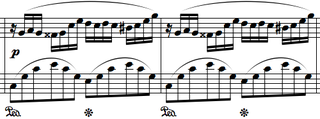Sonata form is a musical structure generally consisting of three main sections: an exposition, a development, and a recapitulation. It has been used widely since the middle of the 18th century.
The Piano Quintet in F minor, Op. 34, by Johannes Brahms was completed during the summer of 1864 and published in 1865. It was dedicated to Her Royal Highness Princess Anna of Hesse. As with most piano quintets composed after Robert Schumann's Piano Quintet (1842), it is written for piano and string quartet.

Grigory Lipmanovich Sokolov is a Russian naturalized Spanish pianist. He is among the most esteemed of living pianists, his repertoire spanning composers from the Baroque period such as Bach, Couperin or Rameau up to Schoenberg and Arapov. He regularly tours Europe and resides in Italy.

Frédéric Chopin's Fantaisie-Impromptu in C♯ minor, Op. posth. 66, WN 46 is a solo piano composition. It was composed in 1834 and published posthumously in 1855 despite Chopin's instruction that none of his unpublished manuscripts be published. The Fantaisie-Impromptu is one of Chopin's most frequently performed and popular compositions.

Six moments musicaux, Op. 16, is a set of solo piano pieces composed by the Russian composer Sergei Rachmaninoff between October and December 1896. Each Moment musical reproduces a musical form characteristic of a previous musical era. The forms that appear in Rachmaninoff's incarnation are the nocturne, song without words, barcarolle, virtuoso étude, and theme and variations.
C minor is a minor scale based on C, consisting of the pitches C, D, E♭, F, G, A♭, and B♭. Its key signature consists of three flats. Its relative major is E♭ major and its parallel major is C major.
A-flat major is a major scale based on A♭, with the pitches A♭, B♭, C, D♭, E♭, F, and G. Its key signature has four flats.
E-flat minor is a minor scale based on E♭, consisting of the pitches E♭, F, G♭, A♭, B♭, C♭, and D♭. Its key signature consists of six flats. Its relative key is G-flat major and its parallel key is E-flat major. Its enharmonic equivalent, D-sharp minor, contains the same number of sharps.
A-flat minor is a minor scale based on A♭, consisting of the pitches A♭, B♭, C♭, D♭, E♭, F♭, and G♭. Its key signature has seven flats. Its relative major is C-flat major, its parallel major is A-flat major, and its enharmonic equivalent is G-sharp minor.

Radu Lupu was a Romanian pianist. He was widely recognized as one of the greatest pianists of his time.

Peter Roy Katin was a British classical pianist and teacher.
The Piano Sonata in A minor D. 845 (Op.42) by Franz Schubert is a sonata for solo piano. Composed in May 1825 and entitled Premiere Grande Sonata, it is the first of three sonatas published during the composer's lifetime, the others being D.850 and D.894. Conceived as a set, these works were composed during what was reportedly a period of relatively good health and spirits for Schubert, and are praised for their quality and ambition. This first sonata in particular marks a significant step toward the composer’s mature piano sonata style; the format and several characteristic stylistic elements continue through the last.

Six moments musicaux, D. 780 is a collection of six short pieces for solo piano composed by Franz Schubert. Along with the Impromptus, they are among the most frequently played of all Schubert's piano music, and have been recorded many times. No. 3 in F minor has been arranged by Leopold Godowsky and others.
The Piano Sonata in E major, D 459, is a work for solo piano, composed by Franz Schubert in August 1816. It was first published in 1843, after the composer's death, by Carl August Klemm in Leipzig, in a publication known as Fünf Klavierstücke.

Franz Schubert's last three piano sonatas, D 958, 959 and 960, are his last major compositions for solo piano. They were written during the last months of his life, between the spring and autumn of 1828, but were not published until about ten years after his death, in 1838–39. Like the rest of Schubert's piano sonatas, they were mostly neglected in the 19th century. By the late 20th century, however, public and critical opinion had changed, and these sonatas are now considered among the most important of the composer's mature masterpieces. They are part of the core piano repertoire, appearing regularly on concert programs and recordings.

Javier Perianes is a Spanish classical pianist. He is a participant at many renowned festivals within Spain, including Santander, Granada, Peralada and San Sebastián. He has performed in distinguished concert series throughout the world, having made appearances in New York City's Carnegie Hall, Washington DC Concertgebouw Amsterdam, the Tchaikovsky Conservatory in Moscow, the Shanghai Conservatory, Madrid's Auditorio Nacional, Palau in Barcelona, recitals at the Ravinia and Gilmore International Festivals in Chicago, Festival de La Roque-d'Anthéron in France and the Konzerthaus in Berlin.
Sonatas, duos and fantasies by Franz Schubert include all works for solo piano by Franz Schubert, except separate dances. They also include a number of works for two players: piano four hands, or piano and a string instrument.

The Impromptus, Op. 90, D. 899, are a set of four impromptus for solo piano composed by Franz Schubert in 1827. They were written in the same year as the Impromptus, Op. 142, though only the first two pieces were published during Schubert's lifetime. Together with the latter set, they have become a cornerstone of the piano repertoire.

The Impromptus, Op. posth. 142, D. 935, are a set of four impromptus for solo piano composed by Franz Schubert in 1827. They were written in the same year as the Impromptus, Op. 90, but were not published until 1839, more than a decade after his death. Together with the preceding set, they have become a cornerstone of the piano repertoire.










